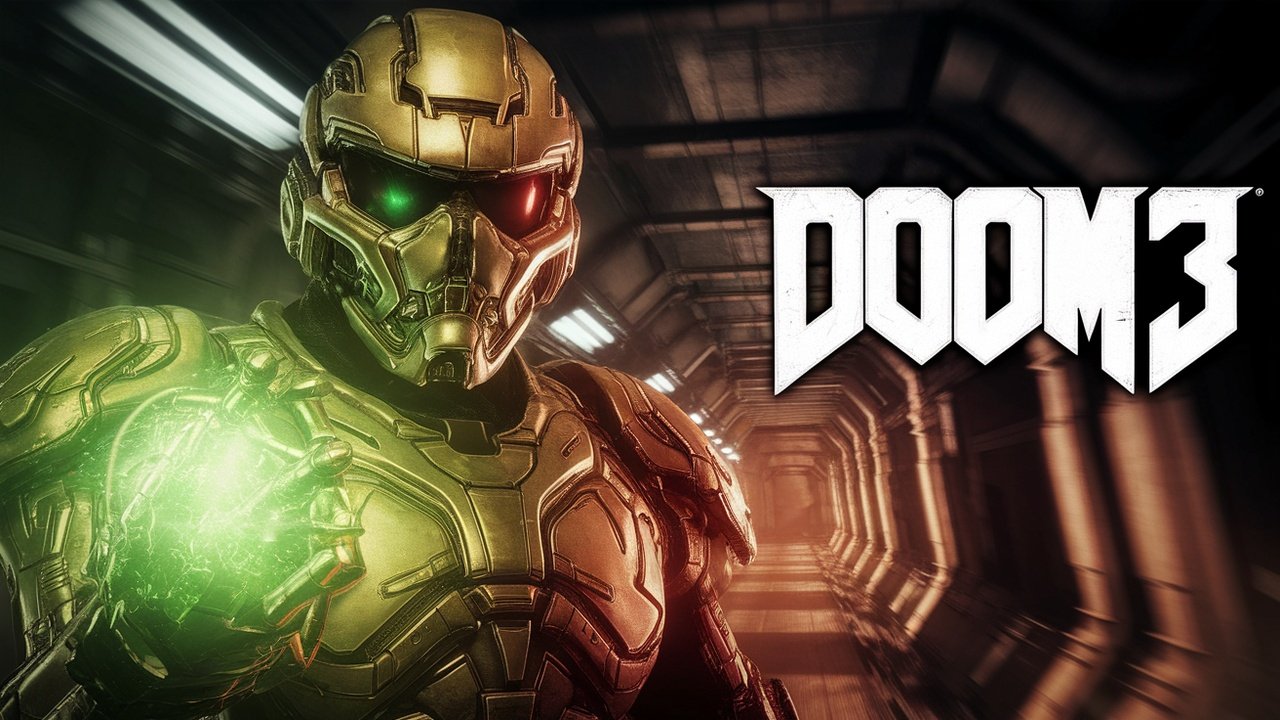Doom 3 vs Halo CE: A Clash of Legends in the FPS Universe

Introduction: A Battle of Icons
In the world of first-person shooters (FPS), two games stand tall as defining titles that helped shape the genre in the early 2000s: Doom 3 and Halo: Combat Evolved (Halo CE).
Both games were monumental releases, showcasing the technical capabilities of their respective platforms while offering vastly different gameplay experiences. But despite their differences, they both earned iconic status and have since been immortalized in the history of gaming.
Released in 2004 and 2001, respectively, Doom 3 and Halo CE have endured in the public consciousness, each holding a unique place in the hearts of fans. Doom 3, developed by id Software, brought a new level of atmospheric horror to the FPS genre with its stunning visuals, eerie ambiance, and terrifying enemies.
On the other hand, Halo CE, developed by Bungie, set the bar for console FPS games with its groundbreaking multiplayer mode, immersive single-player campaign, and revolutionary gameplay mechanics.
In this article, we’ll explore the differences and similarities between these two legendary games. We’ll dive into their gameplay mechanics, storytelling approaches, technical innovations, and lasting legacies, and ultimately answer the question: Which of these two iconic FPS games stands as the true legend of the genre?
Chapter 1: Gameplay Mechanics — Horror vs. Heroism
1.1 Doom 3 – A Dark, Atmospheric Horror Shooter
Doom 3 took the legendary Doom franchise in a new direction. Rather than focusing on the relentless action of its predecessors, it embraced a slower, more atmospheric experience. The game’s focus was on survival horror, with a strong emphasis on exploration, puzzle-solving, and surviving against horrifying demons in the dark corners of the UAC Mars base. The game introduced a dark and claustrophobic environment, where every shadow could hide a terrifying enemy.
The gameplay mechanics of Doom 3 relied heavily on the feeling of fear and isolation. Players were equipped with flashlights that could only be used one at a time with weapons, making combat challenging in dark areas. The enemies in Doom 3 were fast and aggressive, creating tension as players navigated the hellish labyrinth of the UAC base. The combat mechanics were similar to earlier Doom titles but with a slower pace, reflecting the horror influence. The game also featured an upgradeable arsenal of weapons, from the iconic shotgun to the devastating BFG 9000, with each gun feeling powerful but also limited by ammunition scarcity.
Doom 3’s campaign focused on horror themes with disturbing enemies, immersive environments, and a story of demonic invasion. The game was designed to make players feel vulnerable and at the mercy of the terrifying creatures that roamed the dark halls.
1.2 Halo CE – Heroic Sci-Fi Action and Fluid Gameplay
In stark contrast, Halo: Combat Evolved (Halo CE) focused on delivering a more action-packed, heroic experience. As Master Chief, players fought off the alien Covenant and faced off against the terrifying Flood in an epic space opera that played out across lush forests, vast alien ringworlds, and derelict space stations. The game was designed to offer fast-paced, fluid, and highly engaging gameplay that combined a mix of vehicle combat, open-level design, and intense firefights.
One of the most notable gameplay features in Halo CE was its open levels. Unlike Doom 3’s claustrophobic and narrow hallways, Halo’s levels were expansive and encouraged exploration. Players had the option to use vehicles like the Warthog to traverse vast environments, adding an element of mobility and freedom to the gameplay. The game’s combat mechanics allowed players to carry two weapons at once, which was a revolutionary feature at the time.
Combat in Halo CE was fast, dynamic, and designed to keep players on the move. The AI of the Covenant and the Flood added layers of strategy, requiring players to adapt and change tactics in the heat of battle. The game’s pacing, coupled with its innovative use of vehicles and multi-tiered combat arenas, made it one of the most fluid and enjoyable FPS experiences of its era.
Chapter 2: Visuals and Technical Innovations – Pushing the Limits of Their Time
2.1 Doom 3 – A Groundbreaking Visual Experience
When it comes to visuals, Doom 3 was a technical marvel in 2004. Powered by the id Tech 4 engine, the game pushed the limits of what was possible in gaming at the time, boasting unbelievable lighting effects, realistic textures, and detailed character models. The game was hailed for its use of dynamic lighting, which created eerie shadows and illuminated dark environments. The lighting effects helped establish the game’s tense atmosphere, where you never knew what might be lurking in the darkness.
The game’s art design was gothic and hellish, with levels filled with highly detailed architecture, sinister demonic creatures, and terrifyingly atmospheric lighting. Every room, hallway, and vent felt alive with the constant threat of danger, making the world of Doom 3 both beautiful and horrifying. The attention to detail in creating this dark, immersive world made Doom 3 one of the most visually impressive games of its time.
2.2 Halo CE – Vibrant Worlds with Timeless Design
On the other hand, Halo CE took a more colorful and grandiose approach to its visuals. Bungie used the Halo engine to create expansive environments with stunning skyboxes, lush forests, and grandiose alien architecture. While the game wasn’t as focused on realistic lighting effects as Doom 3, the visual design of Halo CE was ahead of its time in terms of the scale of its environments and the art direction. The expansive ringworld of Halo itself became a defining visual icon in the series, offering players a visually stunning backdrop for the game’s action.
The character models in Halo CE were less detailed than Doom 3’s, but the game’s art direction was a triumph, with its vibrant colors and large-scale environments that felt alive and engaging. The game’s environments were not just visually stunning but also highly interactive, with players engaging in firefights in large, open arenas, often with vehicles or on foot. The visuals in Halo CE were designed to complement the game’s gameplay, creating a sense of immersion and scale that made the experience feel epic.
Chapter 3: Storytelling and Atmosphere – A Tale of Two Narratives
3.1 Doom 3 – A Dark Tale of Horror and Despair
Doom 3 was a game that leaned heavily on atmosphere and dread to tell its story. The plot was set on Mars, where a scientific expedition by the UAC (Union Aerospace Corporation) accidentally opens a portal to Hell, unleashing a horde of demons. As the unnamed marine, players were tasked with navigating the UAC base to survive the demonic outbreak and uncover the truth behind the portal.
The game relied on environmental storytelling, with scattered audio logs, datacubes, and video messages to tell the story. This method allowed players to uncover details about the background and motivations of the characters and events. The isolating environment, combined with the horrific nature of the demons, gave the game a desperate tone, where survival was the main objective rather than exploration or heroism.
3.2 Halo CE – A Heroic Space Opera
In contrast, Halo CE embraced a traditional sci-fi narrative with a more heroic tone. The story follows Master Chief, a genetically enhanced supersoldier, as he fights to stop the Covenant, a religious alien alliance, from discovering and activating a massive ringworld known as Halo. The story unfolds with cinematic sequences and in-game dialogue, presenting the stakes of the war between humanity and the Covenant, as well as the mysterious threat of the Flood.
Halo CE’s narrative was more straightforward compared to Doom 3’s, but it had an epic quality that appealed to fans of sci-fi and military shooters. The game introduced players to Master Chief and the Covenant while setting up the Halo universe that would become central to the series’ lore. It was a more uplifting and action-driven story, where the player was constantly fighting against overwhelming odds.
Chapter 4: Multiplayer – Revolutionizing the Genre
4.1 Doom 3 – A Limited but Fun Experience
Doom 3 did include a multiplayer mode, but it wasn’t the focus of the game. The multiplayer was limited compared to its predecessors and didn’t garner the same attention as other titles in the genre. However, it still offered fun, fast-paced combat in small arenas, providing a solid if somewhat unremarkable multiplayer experience.
4.2 Halo CE – A Game-Changing Multiplayer Experience
In contrast, Halo CE revolutionized console FPS multiplayer. With split-screen and LAN support, it brought the joy of multiplayer gaming to living rooms, allowing friends to battle against each other in various game modes like Slayer and Capture the Flag. The Warthog, energy shields, and unique weaponry all added layers of strategy and fun to multiplayer matches. Halo CE became one of the most influential multiplayer games in history, laying the groundwork for the future of online console gaming.
Conclusion: The Legacy of Doom 3 and Halo CE
Doom 3 and Halo CE may have shared the FPS spotlight in the early 2000s, but their legacies are vastly different. Doom 3 remains a landmark in atmospheric horror and technical achievement, while Halo CE became the cornerstone of console FPS gaming and multiplayer experiences. Whether you’re drawn to the claustrophobic terror of Doom or the expansive heroism of Halo, both games hold a special place in gaming history.
In the end, the choice between Doom 3 and Halo CE comes down to personal preference—do you prefer the dark, isolated horrors of Doom, or the epic, heroic battles of Halo? Regardless of which side you choose, both games have earned their spots as legends in the world of FPS gaming.





